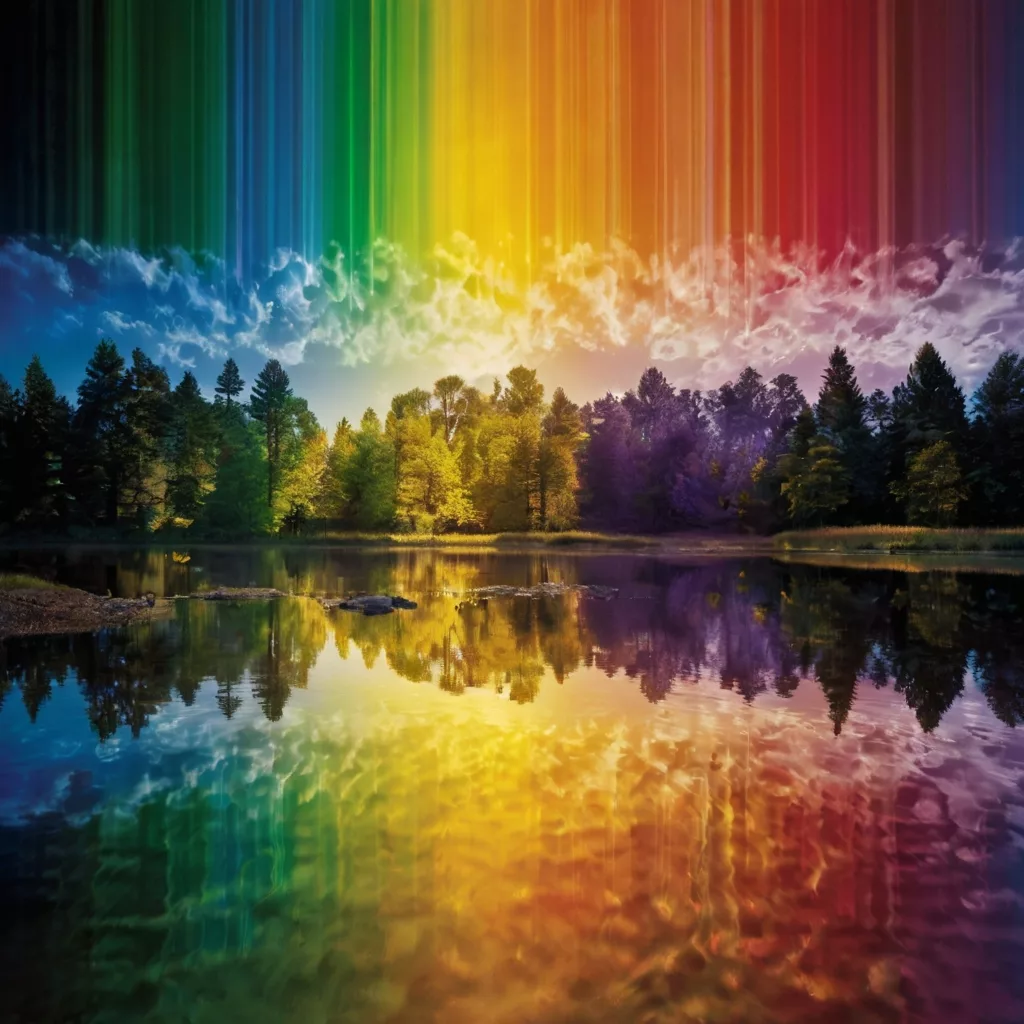The Physical Nature of Color: How We See the Light Spectrum
Understanding the Fascinating Science Behind Our Colorful World
The physical nature of color represents one of the most fascinating intersections of physics, biology, and human perception. When we admire a vibrant sunset, gaze at a rainbow, or choose clothing in our favorite hue, we’re experiencing the remarkable phenomenon of light interacting with our visual system. This comprehensive exploration delves into the intricate science of color perception, examining how electromagnetic radiation transforms into the rich tapestry of colors that define our visual experience.
The Electromagnetic Spectrum: The Foundation of Color
At its most fundamental level, color is the visual perception of light—specifically, how our brains interpret different wavelengths of electromagnetic radiation. The visible light spectrum represents just a tiny fraction of the entire electromagnetic spectrum, which includes radio waves, microwaves, infrared radiation, ultraviolet radiation, X-rays, and gamma rays.
The visible spectrum spans wavelengths from approximately 380 nanometers (violet) to 700 nanometers (red). Each wavelength within this range corresponds to a different color perception:
- Violet: 380-450 nm
- Blue: 450-495 nm
- Green: 495-570 nm
- Yellow: 570-590 nm
- Orange: 590-620 nm
- Red: 620-700 nm
What makes the study of color especially intriguing is that color itself is not an inherent property of light. Rather, color is created by our visual system’s response to different wavelengths. This distinction becomes critically important when understanding how we perceive the physical world around us.
Light Behavior: Reflection, Absorption, and Transmission
When light interacts with objects, three primary phenomena occur: reflection, absorption, and transmission. These interactions determine the colors we perceive.
Reflection
When light strikes an object, some wavelengths are reflected while others are absorbed. The reflected wavelengths determine the color we see. For example, a red apple appears red because it reflects primarily red wavelengths while absorbing most other colors in the visible spectrum.
Reflection can be:
- Specular reflection: Light bounces off a smooth surface at the same angle it hits the surface, creating a mirror-like effect.
- Diffuse reflection: Light hits a rough surface and scatters in many directions, creating a matte appearance.
The quality of reflection significantly impacts our perception of color, contributing to properties like gloss, sheen, and luster.
Absorption
When an object absorbs certain wavelengths of light, those wavelengths are converted into other forms of energy, typically heat. Black objects appear black because they absorb most visible wavelengths, while white objects reflect most wavelengths.
The degree of absorption varies by material and affects not only color perception but also physical properties. For instance, dark-colored clothing absorbs more solar radiation and consequently feels warmer in sunlight than light-colored clothing.
Transmission
Transparent and translucent materials allow light to pass through them. The wavelengths that pass through determine the color we perceive. For example, a blue glass filter appears blue because it transmits primarily blue wavelengths while absorbing or reflecting others.
The selective transmission of light is crucial in various applications, from colored filters in photography to the creation of stained glass art.
The Human Visual System: From Light to Perception
Understanding color requires exploring how our visual system processes light. The journey from external stimulus to color perception involves several sophisticated biological mechanisms.
The Eye’s Structure
Light enters the eye through the cornea, passes through the pupil (the opening in the iris), and is focused by the lens onto the retina. The retina contains two types of photoreceptor cells:
- Rods: Approximately 120 million rod cells provide vision in low-light conditions but do not contribute significantly to color vision.
- Cones: Approximately 6-7 million cone cells enable color vision and function best in bright light.
Three Types of Cone Cells
Humans with typical color vision have three types of cone cells, each sensitive to different wavelength ranges:
- S-cones (short-wavelength): Peak sensitivity around 420-440 nm, corresponding to blue-violet light
- M-cones (medium-wavelength): Peak sensitivity around 530-540 nm, corresponding to green light
- L-cones (long-wavelength): Peak sensitivity around 560-580 nm, corresponding to yellow-green to red light
This three-receptor system forms the basis of the trichromatic theory of color vision, first proposed by Thomas Young in 1802 and later expanded by Hermann von Helmholtz.
From Retina to Brain
When light stimulates the cone cells, they generate electrical signals that travel via the optic nerve to the visual cortex in the brain. The brain processes these signals through a complex series of operations that ultimately produce our subjective experience of color.
The processing occurs through two primary pathways:
- Opponent process: Colors are processed in opposing pairs (red-green, blue-yellow, black-white)
- Parallel processing: Different aspects of visual information (color, form, motion) are processed simultaneously in separate brain regions
This complex neural processing explains various color phenomena, including color constancy (perceiving an object’s “true” color despite changes in illumination) and afterimages (seeing complementary colors after staring at a colored image).
Color Mixing: Additive and Subtractive Models
Understanding how colors combine provides crucial insights into both natural color phenomena and technological applications.
Additive Color Mixing
Additive color mixing occurs when different wavelengths of light combine. The primary colors in additive mixing are red, green, and blue (RGB). When these primaries combine in equal intensities, they produce white light.
- Red + Green = Yellow
- Red + Blue = Magenta
- Green + Blue = Cyan
- Red + Green + Blue = White
Additive color mixing applies to scenarios where light is directly emitted, such as in television screens, computer monitors, theatrical lighting, and smartphone displays.
Subtractive Color Mixing
Subtractive color mixing occurs when pigments, dyes, or filters remove specific wavelengths from light. The primary colors in subtractive mixing are cyan, magenta, and yellow (CMY), often with black (K) added for practical purposes (CMYK).
- Cyan + Magenta = Blue
- Cyan + Yellow = Green
- Magenta + Yellow = Red
- Cyan + Magenta + Yellow = Black (theoretically, though in practice, a dark brown results)
Subtractive color mixing applies to printed materials, paintings, and other scenarios where colors are created through the absorption and reflection of light.
Measuring and Describing Color
To communicate about color effectively, scientists, artists, and designers have developed various systems for measuring and describing color.
Color Dimensions
Colors can be characterized along three primary dimensions:
- Hue: The specific wavelength of light that determines the named color (red, blue, green, etc.)
- Saturation (or chroma): The purity or intensity of a color, from dull/grayish to pure/vivid
- Brightness (or value/lightness): The relative lightness or darkness of a color
These dimensions provide a three-dimensional way to map the color space and form the basis for color organization systems.
Color Models and Systems
Numerous color models have been developed to standardize color description and reproduction:
- RGB (Red, Green, Blue): Used primarily for digital displays
- CMYK (Cyan, Magenta, Yellow, Key/Black): Used primarily for printing
- HSB/HSV (Hue, Saturation, Brightness/Value): More intuitive for human color selection
- CIE colorspace models: Science-based models accounting for human color perception
- CIE XYZ (1931)
- CIE Lab (1976)
- CIE LUV (1976)
- Munsell Color System: An early attempt to create a perceptually uniform color space organized by hue, value, and chroma
- Natural Color System (NCS): Based on how humans perceive color relationships
- Pantone Matching System (PMS): A proprietary color matching system widely used in industry
These systems enable precise color specification, crucial for applications ranging from commercial printing to digital media production.
Color Vision Anomalies
Not everyone experiences color in the same way. Variations in color perception highlight the subjective nature of color experience.
Color Vision Deficiencies
Approximately 8% of men and 0.5% of women have some form of color vision deficiency, commonly called “color blindness.” These conditions result from genetic variations affecting cone cell functionality:
- Deuteranomaly/Deuteranopia: Reduced or missing M-cone (green) function, resulting in difficulty distinguishing between reds, greens, and yellows
- Protanomaly/Protanopia: Reduced or missing L-cone (red) function, with similar red-green confusion plus reduced sensitivity to red light
- Tritanomaly/Tritanopia: Rare conditions affecting S-cone (blue) function, causing confusion between blues and greens, and yellows and violets
- Monochromacy: Extremely rare condition where only one type of cone functions, or only rods function, resulting in complete color blindness
Understanding these variations is essential for designing inclusive visual communications and interfaces.
Tetrachromacy
At the other end of the spectrum, some individuals (almost exclusively women) may possess four types of cone cells rather than three, potentially enabling them to perceive a wider range of colors. This condition, called tetrachromacy, remains an active area of research, with implications for our understanding of color perception diversity.
The Physics of Interesting Color Phenomena
Several fascinating optical phenomena demonstrate the complex interactions between light, matter, and perception.
Dispersion and Rainbows
When white light passes through a prism or water droplets, different wavelengths refract at slightly different angles—a phenomenon called dispersion. This separation of wavelengths creates the spectacular rainbow effect, whether in natural rainbows or laboratory demonstrations.
Structural Colors
Not all colors result from pigments. Some of the most vibrant colors in nature come from microscopic structures that selectively reflect specific wavelengths through interference, diffraction, or scattering. Examples include:
- The iridescent blue of Morpho butterfly wings
- The changing colors of peacock feathers
- The metallic appearance of certain beetles
- The blue of some bird feathers
- The shimmering colors of mother-of-pearl
Structural colors often appear particularly vibrant and can change depending on viewing angle.
Thin-Film Interference
When light interacts with extremely thin transparent films (on the order of the wavelength of light), interference between light reflected from the top and bottom surfaces creates vivid colors. We see this effect in soap bubbles, oil slicks on water, and anti-reflective coatings on camera lenses.
Fluorescence and Phosphorescence
Some materials absorb light at one wavelength and emit it at another:
- Fluorescence: Material instantly re-emits absorbed light at a longer wavelength
- Phosphorescence: Material stores absorbed energy and releases it slowly over time
These phenomena explain the glow of highlighter pens under UV light and the persistent glow of “glow-in-the-dark” toys.
Color in Technology
Our understanding of color has enabled numerous technological applications.
Display Technologies
Modern displays use various technologies to recreate colors:
- LCD (Liquid Crystal Display): Uses liquid crystals to control light passing through color filters
- OLED (Organic Light Emitting Diode): Pixels directly emit colored light when electrically stimulated
- Quantum Dot: Uses semiconductor nanocrystals to produce pure, specific wavelengths
- E-ink: Reflects ambient light rather than emitting light, similar to printed paper
Each technology offers different advantages in color reproduction, energy efficiency, and viewing experience.
Color Reproduction
Accurate color reproduction remains challenging across different media:
- Color Gamut: The range of colors a device can display or a medium can reproduce
- Color Management: Systems and techniques to maintain consistent color appearance across devices
- ICC Profiles: Standardized files that characterize how devices reproduce color
- Color Calibration: Processes to adjust devices to known standards
These concepts are vital in fields requiring precise color, from photography to product manufacturing.
Color Sensing and Analysis
Technologies for measuring and analyzing color include:
- Spectrophotometers: Measure the wavelengths reflected or transmitted by objects
- Colorimeters: Measure colors as perceived by humans using filters that approximate human vision
- Digital Color Sensors: Electronic components that detect color in automation systems
These instruments enable quality control in manufacturing, art conservation, medical diagnostics, and countless other applications.
Cultural and Psychological Dimensions of Color
While the physical nature of color is universal, its interpretation varies significantly across cultures and contexts.
Cultural Meanings of Color
Color symbolism differs dramatically across cultures:
- White: Represents purity in Western cultures but mourning in many Eastern cultures
- Red: Symbolizes luck and celebration in China but can signify danger or passion in Western contexts
- Purple: Historically associated with royalty in many cultures due to the rarity of purple dyes
- Blue: Often associated with trust and stability in Western business contexts
These cultural associations profoundly impact design, marketing, and cross-cultural communication.
Psychological Effects
Colors can influence psychological states and behaviors:
- Red: Can increase heart rate and create feelings of urgency
- Blue: Often produces calming effects and impressions of trustworthiness
- Green: Associated with nature, renewal, and restfulness
- Yellow: Can evoke feelings of optimism but may cause visual fatigue when overused
These effects, while sometimes subtle and context-dependent, have significant implications for environmental design, marketing, and user interface development.
Historical Perspectives on Color Science
Our understanding of color has evolved dramatically over centuries.
Ancient Theories
Early civilizations developed sophisticated, if incomplete, theories about color:
- Ancient Greeks: Aristotle proposed that colors existed on a continuum between white and black
- Ancient China: Developed a system connecting colors to the five elements and natural processes
- Ancient India: Associated colors with chakras and spiritual energy
Scientific Developments
Key scientific advances transformed our understanding of color:
- Isaac Newton (1666-1672): Demonstrated that white light contains all colors through his prism experiments
- Thomas Young (1802): Proposed the trichromatic theory of color vision
- James Clerk Maxwell (1861): Created the first color photograph, confirming the principles of additive color mixing
- Hermann von Helmholtz (1850s-1860s): Expanded understanding of color perception and mixing
- Ewald Hering (1870s): Proposed the opponent process theory of color vision
- CIE (1931): Established the first standardized colorimetric system
Each advancement built upon previous knowledge, gradually revealing the complex relationship between physical light, human biology, and color perception.
The Future of Color Science and Technology
Color science continues to advance, with exciting implications for both technology and our understanding of perception.
Emerging Research Areas
Current research frontiers include:
- Non-human color perception: Understanding how other species perceive colors differently from humans
- Multispectral imaging: Capturing and analyzing information beyond visible wavelengths
- Quantum color effects: Exploring how quantum mechanics influences color at the nanoscale
- Neural correlates of color: Mapping exactly how the brain processes color information
- Advanced structural colors: Developing new materials with tunable optical properties
Technological Innovations
Emerging technologies promise to transform how we experience color:
- Extended color gamut displays: Technologies capable of reproducing a wider range of perceivable colors
- Dynamic structural color materials: Materials that can change color in response to environmental factors
- Increased bit depth in imaging: Enabling more subtle color gradations in digital media
- Advanced colorimetry tools: More accessible and precise color measurement devices
- Personalized color experiences: Technologies that adapt to individual color perception differences
Conclusion: The Endless Fascination of Color
The physical nature of color represents a remarkable convergence of physics, biology, psychology, and culture. From the quantum interactions that determine which wavelengths materials absorb and reflect, to the neural processing that transforms light into perception, to the cultural contexts that give colors meaning—color science offers endless opportunities for exploration and discovery.
As we continue to unravel the mysteries of color perception, we gain not only scientific knowledge but also new tools for artistic expression, communication, and technological innovation. The study of color reminds us that even the most familiar aspects of our perceptual world contain profound complexities worth investigating.
Whether you’re a physicist exploring the quantum nature of light, a neuroscientist mapping visual pathways, an artist exploiting the emotional power of color, or simply someone who appreciates a vibrant sunset, the science of color enriches our understanding of both the physical world and our unique human experience of it.
References and Further Reading
- Nassau, K. (2001). The Physics and Chemistry of Color: The Fifteen Causes of Color. Wiley-Interscience.
- Fairchild, M.D. (2013). Color Appearance Models. Wiley.
- Kuehni, R.G. (2003). Color Space and Its Divisions: Color Order from Antiquity to the Present. Wiley-Interscience.
- Livingstone, M. (2014). Vision and Art: The Biology of Seeing. Abrams.
- Shevell, S.K. (Ed.). (2003). The Science of Color. Optical Society of America.
- Finlay, V. (2014). The Brilliant History of Color in Art. Getty Publications.
- Ball, P. (2003). Bright Earth: Art and the Invention of Color. University of Chicago Press.
- Gage, J. (1999). Color and Culture: Practice and Meaning from Antiquity to Abstraction. University of California Press.
- Gurney, J. (2010). Color and Light: A Guide for the Realist Painter. Andrews McMeel Publishing.
- Feisner, E.A., & Reed, R. (2013). Color Studies. Fairchild Books.
This article provides a comprehensive overview of color physics and perception, but the field continues to evolve. Readers are encouraged to explore recent scientific literature for the latest discoveries in this fascinating area of study.







